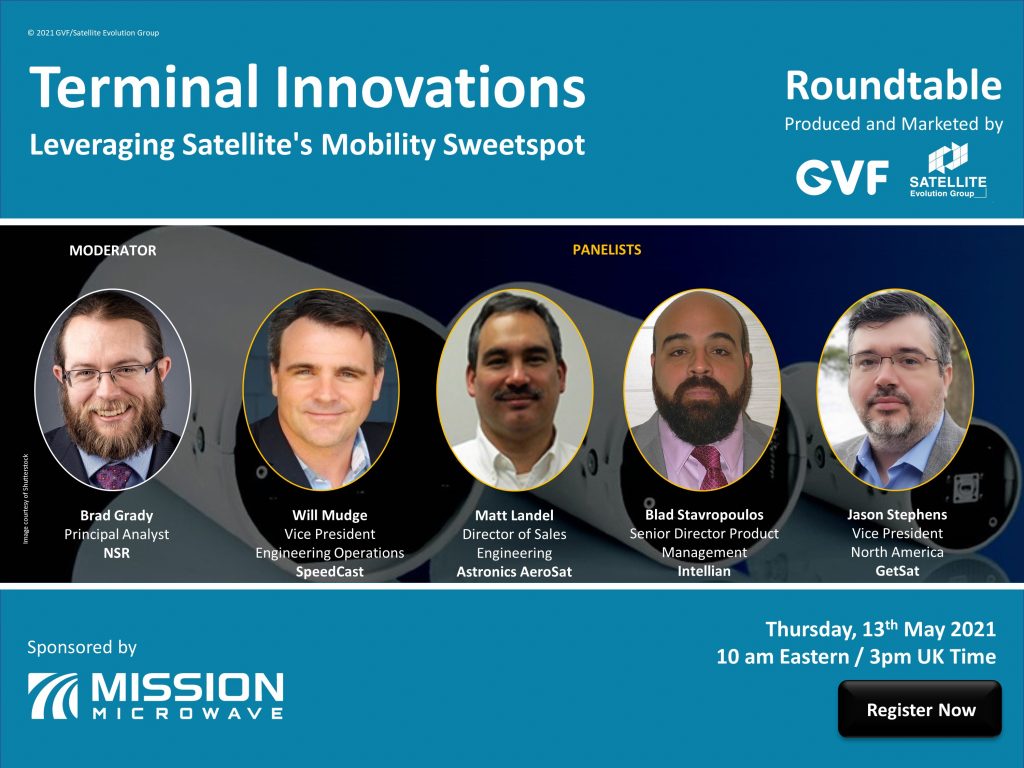Let’s Zoom Again!
by Martin Jarrold
London, UK, May 5, 2021--The GVF-Satellite Evolution Group (SEG) Webinar Series is approaching its first anniversary. For events across the last year we have been fortunate to have featured a diverse range of great moderators, as well as exciting populations of insightful contributors covering a broad spectrum of subjects.
Just recently, during April, I had the opportunity to return to the moderator’s chair, working with panelists to consider the expansion of network connectivity using space-based solutions across two regions: Africa; and Europe, Middle East & North Africa (EMENA).
On 20 April Expand Your Network Connectivity Across Africa with Space-based Solutions included discussion centered on Connecting Africa to Broadband: A Roadmap for Inclusive Growth featuring four expert panelists from Liquid Satellite, Orange DRC, Safaricom, and Vodacom Mozambique, and which began by referencing three World Bank observations about communications and connectivity in Africa.
Firstly, that it will require an investment of US$100 Billion to achieve universal, affordable and good quality internet access for the continent’s 1.1 Billion people by 2030.
Secondly, for the most part, universal access to broadband connectivity is an infrastructure challenge with nearly 80 percent of all required investment directly tied to the need to roll out and maintain broadband networks.
Thirdly, the impact of the pandemic on communication and connectivity has been felt within the ecosystem surrounding the internet and communications technology, increasing demand and highlighting the need to leverage tools and innovative strategies.
The panel considered a wide range of questions, beginning with an evaluation of what in Universal Access strategies to enable the bridging of Africa’s Digital Divide has failed to work in the past, and what is new about different approaches being proposed today, and following-up on the World Bank observation the panelists gave their respective appraisals of the ways, and with what effects, the COVID-19 pandemic has magnified the continent’s lack of broadband connectivity progress and the more urgent need for that progress.
Further questions included the benefits to mobile network operator (MNO) planning strategies of including satellite-based solutions, especially that for covering rural areas; how satellite fits with the CAPEX and OPEX demands of MNOs in terms of keeping costs to customers low; how high-throughput satellites, with slashed bandwidth costs and significantly increased capacity, have altered the business equation of MNOs in satellite’s favor; and, the ways MNOs can address mobile device and service plan affordability issues in remote rural areas, balancing the demands of customer affordability and company revenue growth and RoI.
Following the panel, a fireside chat with representatives of Intelsat and TinSky Connect, based out of South Africa, considered Connectivity Imagined… Where You Need It, When You Need It. Backdrop to the conversation was acknowledgement that industries all over Africa depend on reliable communications to keep them connected everywhere they do business, with users in mining, rail, oil & gas, first responders, civil defense, and humanitarian aid discovering innovative ways to optimize their operations in hard-to-reach locations or where other networks simply don’t exist.
On 22 April, GVF hosted the Intelsat-sponsored Expand Your Network Connectivity Across Europe & MENA with Space-based Solutions, including a moderated discussion, Enterprise Networking: Meeting the Challenges of Growing Complexity, Expanding Needs. The foundation perspective of this 60-minute dialog was that ‘hyper-connectivity’ is now a global phenomenon. Enterprises worldwide are increasingly dependent upon reliable access to information, applications, secure networks, and productivity tools. Enterprise networking, via turnkey managed services or wholesale capacity-only options, provides enables businesses to seize emerging opportunities, accelerate decision-making, and bring more value to customers.
Three experts, representing Algeria Telecom Satellite, Media Broadcast Satellite, and Orange Business Services, explored innovations that are transforming satellite solutions, supporting enterprise applications and services securely, reliably, and cost-effectively, and as a starting point considered if there are particular vertical markets across EMENA for which the role of satellite in advancing solutions to the challenges of growing complexity and expanding needs in enterprise networking is of particular and growing importance.
 Further questioning examined the most important and complementary advances in the space segment and ground segment contributing to advancing satellite solutions for enterprises across EMENA, and how enterprise sector digital transformation will secure the long-term sustainability of the enterprise VSAT market. Other questions covered changes in the enterprise solutions marketplace arising from the dramatically reduced cost of bandwidth and dramatically increased capacity of high throughput satellites, and the degree to which this trend is altering the enterprise network solutions equation in satellite’s favor, including when MNOs consider what role satellites should play in their networks. Panelists gave their views on how optimization of cloud networks with satellite-enable SD-WAN will progress in the longer term and referenced again advances in space and ground segment with their expectations of future innovation.
Further questioning examined the most important and complementary advances in the space segment and ground segment contributing to advancing satellite solutions for enterprises across EMENA, and how enterprise sector digital transformation will secure the long-term sustainability of the enterprise VSAT market. Other questions covered changes in the enterprise solutions marketplace arising from the dramatically reduced cost of bandwidth and dramatically increased capacity of high throughput satellites, and the degree to which this trend is altering the enterprise network solutions equation in satellite’s favor, including when MNOs consider what role satellites should play in their networks. Panelists gave their views on how optimization of cloud networks with satellite-enable SD-WAN will progress in the longer term and referenced again advances in space and ground segment with their expectations of future innovation.
The subject Addressing Market Needs: Supporting Enterprise Network Applications Requirements provided the basis for the following fireside chat, which initially looked at key business continuity issues in today’s enterprise networking solutions market across EMENA, and how satellite is well positioned to meet the challenges involved. Discussion then turned to software defined wide area networking (SD-WAN), covering:
• How software-enabled and software-defined services drive interoperability standards which can bring together satellite, terrestrial and wireless solutions across the telecom and networking environment, simplifying services for enterprise.
• The SD-WAN decoupling of networking hardware from its control mechanism, simplifying operation and management of a wide area network by solving challenges related to latency, packet loss, bandwidth limitations, and network congestion and how satellite adds to these advantages.
• How the well-established advantages of SD-WAN (bundling and routing network traffic intelligently and securely across a combination of available wide area network access connections ranging across satellite and terrestrial) manifests itself across the different market verticals across Middle East, and North Africa.
• How the pairing of satellite-based services with SD-WAN creates solutions which bring additional value for enterprises over and above the simplification of networks implementation and management brought by non-paired strategies.
If you missed the original broadcasts on Zoom, you haven’t missed out because recording of the events is available by visiting https://gvf.org/webinar/expand-your-network-connectivity-across-africa-w... and https://gvf.org/webinar/expand-your-network-connectivity-across-europe-m..., respectively.
Next in the GVF-SEG schedule is another in our Roundtable series with Mission Microwave. Moderated by Brad Grady, Principal Analyst, NSR, and featuring Will Mudge, Vice President Engineering Operations, SpeedCast; Matt Landel, Director of Sales Engineering, Astronics AeroSat; Blad Stavropoulos, Senior Director Product Management, Intellian; and, Jason Stephens, Vice President North America, GetSat. Terminal Innovation: Leveraging Satellite’s Mobility Sweetspot takes place on 13 May at 3:00 pm UK time / 10:00 am US Eastern time and will examine On-the-Move (OTM) and mobile applications as a market sweet spot for satellite communications. While ships, ‘planes, trains and tactical platforms are sometimes able to connect to high-speed terrestrial services SATCOM connections are critical to providing a reliable level of service and frequently a SATCOM connection is the only viable solution. The aviation and maritime markets have seen some exciting innovations over the past few years as HTS service offers worked to offer bandwidth to mobile platforms. One example is how advances in RF components and signal processing have made it possible to provide reliable high-speed SATCOM links to helicopters. Rotary aircraft represent a relatively unexplored market segment for SATCOM that is expect to grow from historically near zero to thousands of terminals in the next three to five years.
These Roundtable participants are globally recognisable as industry leaders in designing, building and deploying aviation and maritime SATCOM terminals and will offer their views on the technology trends that affect their current business, the effects of envisioned technologies including ESAs, and the role of transportable terminals in support of much anticipated non-GEO satellite networks. You can read more and register for this event at https://gvf.org/webinar/terminal-innovation-leveraging-satellites-mobility-sweetspot/
There will be further online events in during the month of May and you can keep up to date with the schedule by regularly visiting https://gvf.org/webinars/. Meanwhile, wherever you are whilst reading these words… Keep well, stay safe.
-----------------------------------------------
 Martin Jarrold is Vice-President of International Program Development of GVF. He can be reached at: martin.jarold@gvf.org
Martin Jarrold is Vice-President of International Program Development of GVF. He can be reached at: martin.jarold@gvf.org






